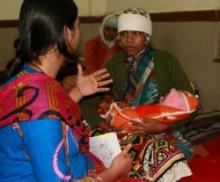
The course will assist USAID field-based health officers, foreign service nationals, and U.S. government partners to promote gender equality and women’s empowerment in health systems strengthening efforts. By the end of the course, the learner will understand how health systems components interact with each other, how gender plays a role in each health systems component, and how to address these gender issues in health systems strengthening activities in order to improve health and social outcomes.
This course will examine gender considerations for each of six health systems components described in the World Health Organization's health systems model. We will also explore ways to promote gender equality and women’s empowerment in health systems strengthening interventions so that health systems better meet the health needs of women, men, girls, and boys. Each section of the course will first discuss and illustrate gender issues that affect a particular health system component and then propose solutions to address these issues and strengthen health systems.
This course will consider some of the gender norms that drive health behavior, health decision making, and the provision and utilization of health care. We will highlight programmatic examples that illustrate aspects of gender equality and women's empowerment in health systems strengthening.
We recommend that learners have a background in health systems strengthening. Learners should complete the prerequisite course Gender and Sexual and Reproductive Health 101 prior to taking this course.
Please note that learners can complete a course over multiple visits and a pick up where they left off at any time.
Objective
At the end of the course, learners will be able to:
- Explain the intersections between gender equality, women’s empowerment, and health systems strengthening.
- Describe the health systems components and their gender considerations.
- Describe key interventions that promote gender equality and women’s empowerment in health systems strengthening.
- Cite examples of the multiple, dynamic interactions among the health systems components that result in positive gender and health systems outcomes.
Credits
The author would like to acknowledge Taroub Faramand (WI-HER) and Jennifer Pendleton (Futures Group) for their substantial assistance in drafting sessions on service delivery and governance. The author would also like to acknowledge the following persons (in alphabetical order) for contributing content and providing valuable review and input:
Michal Avni, USAID; Peggy D'Adamo, USAID; Abigail Donner, Abt Associates; Shelah Bloom, MEASURE Evaluation; Abby Cannon, MEASURE Evaluation; Gloria Coe, USAID; Jessica Fehringer, MEASURE Evaluation; Thobekile Finger, USAID/Southern Africa; Diana Frymus, USAID; Temitayo Ifafore, USAID; Joan Kraft, USAID; Caitlyn Lutfy, WI-HER; Elisabeth Rottach, Futures Group; Diana Santillan, USAID; Lois Schaefer, USAID; Erin Seaver, USAID; Susan Settergren, Futures Group; James Shelton, USAID; and Peter Waithaka, USAID/Kenya.
Time
- 2 hours 30 minutes
Published/Updated
- Wednesday, June 18, 2014
Course Authors:
Constance Newman, CapacityPlus, IntraHealth International
Course Managers:
- Crystal Ng, CapacityPlus, IntraHealth International
- Ann Yang, CapacityPlus, IntraHealth International
- Nandini Jayarajan, CCP
- Lisa Mwaikambo, CCP
Related Courses
Related Toolkits
- Gender Discrimination and Health Workforce Development: An Advocacy Tool
- Promoting Gender Equality in the Health Workforce: An Advocacy Tool
